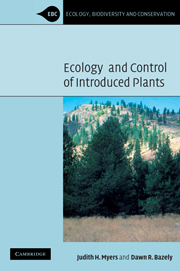Book contents
- Frontmatter
- Contents
- Preface
- 1 Introduction
- 2 Planet of Weeds: exotic plants in the landscape
- 3 Biological invasions in the context of plant communities
- 4 Predicting invasiveness from life history characteristics
- 5 Population ecology and introduced plants
- 6 Introduced plant diseases
- 7 Biological control of introduced plants
- 8 Modeling invasive plants and their control
- 9 Action against non-indigenous species
- 10 Genetically modified plants and final conclusions
- Appendix
- References
- Index
3 - Biological invasions in the context of plant communities
Published online by Cambridge University Press: 02 December 2009
- Frontmatter
- Contents
- Preface
- 1 Introduction
- 2 Planet of Weeds: exotic plants in the landscape
- 3 Biological invasions in the context of plant communities
- 4 Predicting invasiveness from life history characteristics
- 5 Population ecology and introduced plants
- 6 Introduced plant diseases
- 7 Biological control of introduced plants
- 8 Modeling invasive plants and their control
- 9 Action against non-indigenous species
- 10 Genetically modified plants and final conclusions
- Appendix
- References
- Index
Summary
In the first part of this chapter, we consider what makes an ecosystem or community prone to invasion by an introduced species. In the second part we look at the impacts of invasive plant species on communities and ecosystems. These two issues are critical to the interpretation that non-indigenous species are large contributors to the current biodiversity crisis (D'Antonio and Vitousek 1992, Chapin et al. 1998). To begin we briefly review relevant theory on the role of plants in communities in a broader ecological framework. In particular we begin by discussing the invasion of plants into communities as a dimension of the succession process.
Part 1 – Characteristics of native plant communities that influence plant invasions
The invasion of an introduced species into communities is a special case of plant succession. Succession, which was a major focus in early studies of plant ecology, determines the diversity of plant species in communities and this process continues to fascinate ecologists. In the late 1800s, Eugene Warming wrote the first book on plant ecology and in it he recognized that abiotic conditions such as soil type and soil moisture influence plant distributions (Sheail 1987).
Frederick Clements (1916) developed the first theory of plant succession and described the stages of vegetation development (Bradshaw 1993, Miles and Walton 1993). Clements viewed plant community development as a process that begins with bare substrate and progresses through a series of ‘seres’ or stages. Each stage gives way to the next until the ‘climax’ community is reached.
- Type
- Chapter
- Information
- Ecology and Control of Introduced Plants , pp. 51 - 88Publisher: Cambridge University PressPrint publication year: 2003

